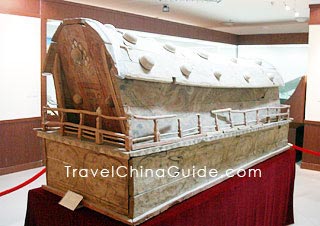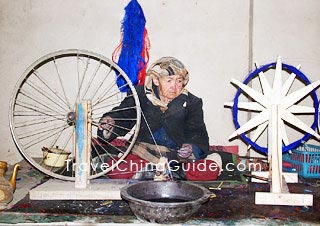Hotan (Hetian) Attractions
 |
| Colored Wooden Coffin in Hotan Museum |
Hotan (Hetian) was always a hustling center on the south route of the ancient Silk Road and prospered when the road made an unprecedented prosperity during the Sui (581-618) and Tang (618-907) dynasties. It was one of the three shining commercial passages of silk in Xinjiang's history. In today's 'silk capital' Hetian, many ruins of historical cultural relics still stand in desert, muttering its previous brilliancy.
The Ancient City of Niya is a major national cultural relic regarded as the 'Eastern Pompeii'. The Ancient City of Mallikurwatur and Ancient City of Yoktan are also shining gems among the civilized treasure in Hetian. Several artifacts unearthed from these three age-old cities can be seen in the Hotan Museum which showcases the region's history over the past thousands of years. Once called Yutian, this place was the habitat of several kingdoms in remote times before the Yutian State got rising under the jurisdiction of the Protectorate of Xiyu (West Regions) and subdued the nearby states in the Eastern Han Dynasty(24-220). Its sphere of influence is roughly equivalent to current Hetian Region. The Ancient City of Niya in Minfeng County is considered to be the most influential relic of the area, which is always the concern of explorers and archeologists since it was first discovered by a British scientist in 1901.
 |
| An elderly woman spin thread from the silkworm cocoon, Silk Village in Hotan |
Hetian Oasis surrounded by desert is a vital producing area of agricultural and cash crops. Vines planted along roads to save plowland are miracles created by farmers of Bageqi Town. Passing through the grape corridors, you may not begrudge the applauses to the spectacle which turns the whole town into a big vineyard.
As a silk capital with time-honored history of sericulture and filature, Hotan is also famed for nephrite jade. Kunlun is a mountain producing jade, which was known long time ago. Alemasi Jade Mine in southern Yutian County is a famous jade mining area in depth of Kunlun Mountains with more than 100 years of mining history. Yorungkash and Karakash rivers (known as the White Jade River and the Black Jade River in history) are main producing areas of jade. Flash flood rushed down the Kunlun Mountains and brought jade ore to the rivers which became jade thought tens of thousand years' washing and polishing. Local people picked up jade in the White Jade River for generations after the flood subsided. Many tourists would like to visit Alemasi and the rivers to try their fortunes.
- Last updated on Jul. 18, 2022 -